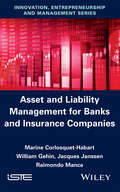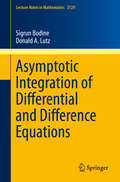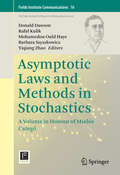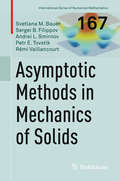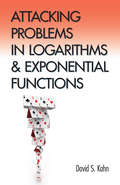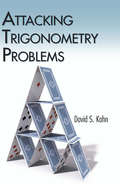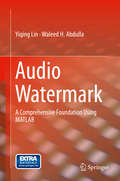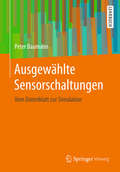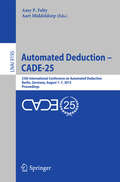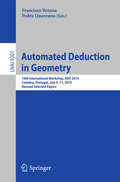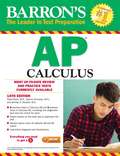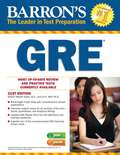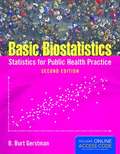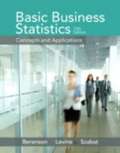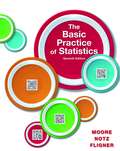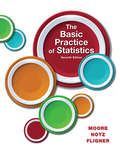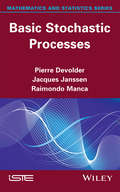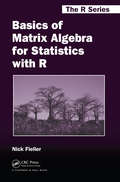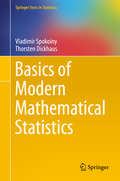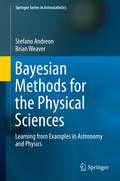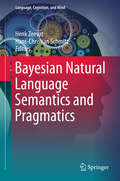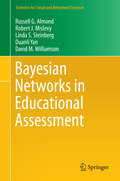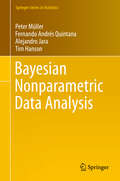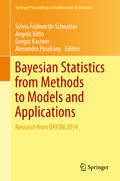- Table View
- List View
Asset and Liability Management for Banks and Insurance Companies
by Jacques Janssen William Gehin Marine Corlosquet-Habart Raimondo MancaThis book introduces ALM in the context of banks and insurance companies. Although this strategy has a core of fundamental frameworks, models may vary between banks and insurance companies because of the different risks and goals involved. The authors compare and contrast these methodologies to draw parallels between the commonalities and divergences of these two services and thereby provide a deeper understanding of ALM in general.
Asymptotic Integration of Differential and Difference Equations (Lecture Notes in Mathematics #2129)
by Sigrun Bodine Donald A. LutzThis book presents the theory of asymptotic integration for both linear differential and difference equations. This type of asymptotic analysis is based on some fundamental principles by Norman Levinson. While he applied them to a special class of differential equations, subsequent work has shown that the same principles lead to asymptotic results for much wider classes of differential and also difference equations. After discussing asymptotic integration in a unified approach, this book studies how the application of these methods provides several new insights and frequent improvements to results found in earlier literature. It then continues with a brief introduction to the relatively new field of asymptotic integration for dynamic equations on time scales. Asymptotic Integration of Differential and Difference Equations is a self-contained and clearly structured presentation of some of the most important results in asymptotic integration and the techniques used in this field. It will appeal to researchers in asymptotic integration as well to non-experts who are interested in the asymptotic analysis of linear differential and difference equations. It will additionally be of interest to students in mathematics, applied sciences, and engineering. Linear algebra and some basic concepts from advanced calculus are prerequisites.
Asymptotic Laws and Methods in Stochastics: A Volume in Honour of Miklós Csörgő (Fields Institute Communications #76)
by Donald Dawson Rafal Kulik Mohamedou Ould Haye Barbara Szyszkowicz Yiqiang ZhaoThis book contains articles arising from a conference in honour of mathematician-statistician Miklá½¹s CsörgÅ' on the occasion of his 80th birthday, held in Ottawa in July 2012. It comprises research papers and overview articles, which provide a substantial glimpse of the history and state-of-the-art of the field of asymptotic methods in probability and statistics, written by leading experts. The volume consists of twenty articles on topics on limit theorems for self-normalized processes, planar processes, the central limit theorem and laws of large numbers, change-point problems, short and long range dependent time series, applied probability and stochastic processes, and the theory and methods of statistics. It also includes CsörgÅ''s list of publications during more than 50 years, since 1962.
Asymptotic methods in mechanics of solids (International Series of Numerical Mathematics #167)
by Svetlana M. Bauer Sergei B. Filippov Andrei L. Smirnov Petr E. Tovstik Rémi VaillancourtThe construction of solutions of singularly perturbed systems of equations and boundary value problems that are characteristic for the mechanics of thin-walled structures are the main focus of the book. The theoretical results are supplemented by the analysis of problems and exercises. Some of the topics are rarely discussed in the textbooks, for example, the Newton polyhedron, which is a generalization of the Newton polygon for equations with two or more parameters. After introducing the important concept of the index of variation for functions special attention is devoted to eigenvalue problems containing a small parameter. The main part of the book deals with methods of asymptotic solutions of linear singularly perturbed boundary and boundary value problems without or with turning points, respectively. As examples, one-dimensional equilibrium, dynamics and stability problems for rigid bodies and solids are presented in detail. Numerous exercises and examples as well as vast references to the relevant Russian literature not well known for an English speaking reader makes this a indispensable textbook on the topic.
Attacking Problems in Logarithms and Exponential Functions (Dover Books on Mathematics)
by David S. KahnThis original volume offers a concise, highly focused review of what high school and beginning college students need to know in order to solve problems in logarithms and exponential functions. Numerous rigorously tested examples and coherent to-the-point explanations, presented in an easy-to-follow format, provide valuable tools for conquering this challenging subject. The treatment is organized in a way that permits readers to advance sequentially or skip around between chapters. An essential companion volume to the author's Attacking Trigonometry Problems, this book will equip students with the skills they will need to successfully approach the problems in logarithms and exponential functions that they will encounter on exams.
Attacking Trigonometry Problems (Dover Books on Mathematics)
by David S. KahnThis volume offers a concise, highly focused review of what high school and beginning college undergraduates need to know to successfully solve the trigonometry problems they will encounter on exams. Rigorously tested examples and coherent, to-the-point explanations are presented in an accessible form and will provide valuable assistance in conquering this challenging subject.Rather than serving as a text or treatise, the book focuses on the essentials of trigonometry. All fourteen sections are organized in a manner that allows readers to advance sequentially or to skip around. The approach encourages memorization of ratios and formulas, and the practice problems offer ample opportunities to become comfortable with applying the trig ratios to a variety of settings.
Audio Watermark: A Comprehensive Foundation Using MATLAB
by Yiqing Lin Waleed H. AbdullaThis book illustrates the commonly used and novel approaches of audio watermarking for copyrights protection. The author examines the theoretical and practical step by step guide to the topic of data hiding in audio signal such as music, speech, broadcast. The book covers new techniques developed by the authors are fully explained and MATLAB programs, for audio watermarking and audio quality assessments and also discusses methods for objectively predicting the perceptual quality of the watermarked audio signals. Explains the theoretical basics of the commonly used audio watermarking techniques Discusses the methods used to objectively and subjectively assess the quality of the audio signals Provides a comprehensive well tested MATLAB programs that can be used efficiently to watermark any audio media
Ausgewählte Sensorschaltungen: Vom Datenblatt zur Simulation
by Peter BaumannIn diesem Buch werden die Schritte angegeben, mit denen man aus den Datenblättern der Sensor-Hersteller die Modellparameter ermitteln kann, die zu einer Schaltungssimulation benötigt werden. Des Weiteren wird gezeigt, wie dem jeweiligen Sensor die Abhängigkeit von Temperatur, Feuchte, Licht, Druck, Kraft oder Magnetfeld in Gleichungsform aufge-prägt werden kann. Zu Sensorschaltungen wie Bandabstandsquelle, Feuchtesensor, RGB-Farbsensor, Reflexlichtschranke oder DMS-Brücke auf einem Baustahl-Biegestab werden die PSPICE-Analysen ausführlich dokumentiert. Die simulierten Sensorschaltungen können für sich und als Ausgangspunkt zu Messungen im Rahmen der Bachelor-Ausbildung genutzt werden.
Automated Deduction - CADE-25: 25th International Conference on Automated Deduction, Berlin, Germany, August 1-7, 2015, Proceedings (Lecture Notes in Computer Science #9195)
by Amy P. Felty Aart MiddeldorpThis book constitutes the proceedings of the 25th International Conference on Automated Deduction, CADE-25, held in Berlin, Germany, in August 2015. The 36 revised full papers presented ( 24 full papers and 12 system descriptions) were carefully reviewed and selected from 85 submissions. CADE is the major forum for the presentation of research in all aspects of automated deduction, including foundations, applications, implementations and practical experience.
Automated Deduction in Geometry: 10th International Workshop, ADG 2014, Coimbra, Portugal, July 9-11, 2014, Revised Selected Papers (Lecture Notes in Computer Science #9201)
by Francisco Botana Pedro QuaresmaThis book constitutes the thoroughly refereed post-workshop proceedings of the 10th International Workshop on Automated Deduction in Geometry, ADG 2014, held in Coimbra, Portugal, in July 2014. The 11 revised full papers presented in this volume were carefully selected from 20 submissions. The papers show the trend set of current research in automated reasoning in geometry.
Barron's AP Calculus, 14th edition: The Best Test Preparation For The Advanced Placement Examination (Advanced Placement (ap) Test Preparation Ser.)
by David Bock M.S. Ed. Dennis Donovan Shirley O. HockettBoth Calculus AB and Calculus BC are covered in this comprehensive AP test preparation manual, which has been updated to align with the new curriculum framework taking effect for the 2017 AP Calculus AB and BC exams. The book’s main features include: Four practice exams in Calculus AB and four more in Calculus BC, modified to reflect the new exam formatAll test questions answered with solutions explainedA detailed subject review covering topics for both examsAdvice to students on efficient use of their graphing calculatorsBONUS ONLINE PRACTICE TEST: Students who purchase this book will also get FREE access to one additional full-length online AP Calculus test with all questions answered and explained.
Barron's GRE 21st Edition
by Sharon Weiner Green Ira K. WolfThis newly revised and updated manual presents a test overview of the GRE, test-taking advice, and a timetable for a typical computer-based test. Added features include-- A diagnostic test with an answer key and answer explanations A verbal reasoning review with practice questions in sentence completion and reading comprehension An analytical writing review with scoring guidelines and practice exercises A quantitative reasoning review that includes general math strategies, discrete quantitative questions, quantitative comparison questions, and data interpretation questions Two full-length model GRE tests with answer keys and answer explanations.
Basic Biostatistics: Statistics for Public Health Practice
by B. Burt GerstmanBasic Biostatistics is a concise, introductory text that covers biostatistical principles and focuses on the common types of data encountered in public health and biomedical fields. The text puts equal emphasis on exploratory and confirmatory statistical methods. Sampling, exploratory data analysis, estimation, hypothesis testing, and power and precision are covered through detailed, illustrative examples. The book is organized into three parts: Part I addresses basic concepts and techniques; Part II covers analytic techniques for quantitative response variables; and Part III covers techniques for categorical responses. The Second Edition offers many new exercises as well as an all new chapter on "Poisson Random Variables and the Analysis of Rates." With language, examples, and exercises that are accessible to students with modest mathematical backgrounds, this is the perfect introductory biostatistics text for undergraduates and graduates in various fields of public health. Features: Illustrative, relevant examples and exercises incorporated throughout the book. Answers to odd-numbered exercises provided in the back of the book. (Instructors may requests answers to even-numbered exercises from the publisher. Chapters are intentionally brief and limited in scope to allow for flexibility in the order of coverage. Equal attention is given to manual calculations as well as the use of statistical software
Basic Business Statistics: Concepts and Applications
by Mark L. Berenson David M. Levine Kathryn A. SzabatStatistics is essential for all business majors and this text helps students see the role statistics will play in their own careers by providing examples drawn from all functional areas of business. Guided by principles set by major statistical and business science associations (ASA and DSI), plus the authors' diverse teaching experiences, the Thirteenth Edition of Berenson/Levine/Szabat's Basic Business Statistics continues to innovate and improve the way this course is taught to all students.
The Basic Practice Of Statistics
by David S. Moore William I. Notz Michael A. FlignerDavid Moore's data analysis (conceptual) approach, which revolutionized the introductory statistics textbook, moves students away from formulas and number-crunching, focusing instead on how working statisticians in a variety of fields collect and analyze data, and use the results to tackle real-world problems. The clear, direct way of emphasizing the course's relevance and confronting students' math anxieties is at the heart of the bestselling The Basic Practice of Statistics (BPS). It is also the ideal approach for taking full advantage of the powerful statistical tools and interactive learning features in this new edition's text/media package. Now more than ever, BPS is ready to help students move from reading about statistical practice to practicing statistics themselves. What's in the LaunchPad
The Basic Practice of Statistics: Test Bank
by David S. Moore William I. Notz Michael A. FlignerDavid Moore's data analysis (conceptual) approach, which revolutionized the introductory statistics textbook, moves students away from formulas and number-crunching, focusing instead on how working statisticians in a variety of fields collect and analyze data, and use the results to tackle real-world problems. The clear, direct way of emphasizing the course's relevance and confronting students' math anxieties is at the heart of the bestselling The Basic Practice of Statistics (BPS). It is also the ideal approach for taking full advantage of the powerful statistical tools and interactive learning features in this new edition's text/media package. Now more than ever, BPS is ready to help students move from reading about statistical practice to practicing statistics themselves. What's in the LaunchPad
Basic Stochastic Processes
by Raimondo Manca Jacques Janssen Pierre DevolderThis book presents basic stochastic processes, stochastic calculus including Lévy processes on one hand, and Markov and Semi Markov models on the other. From the financial point of view, essential concepts such as the Black and Scholes model, VaR indicators, actuarial evaluation, market values, fair pricing play a central role and will be presented. The authors also present basic concepts so that this series is relatively self-contained for the main audience formed by actuaries and particularly with ERM (enterprise risk management) certificates, insurance risk managers, students in Master in mathematics or economics and people involved in Solvency II for insurance companies and in Basel II and III for banks.
Basics of Matrix Algebra for Statistics with R (Chapman & Hall/CRC The R Series #31)
by Nick FiellerA Thorough Guide to Elementary Matrix Algebra and Implementation in R Basics of Matrix Algebra for Statistics with R provides a guide to elementary matrix algebra sufficient for undertaking specialized courses, such as multivariate data analysis and linear models. It also covers advanced topics, such as generalized inverses of singular and rectangular matrices and manipulation of partitioned matrices, for those who want to delve deeper into the subject. The book introduces the definition of a matrix and the basic rules of addition, subtraction, multiplication, and inversion. Later topics include determinants, calculation of eigenvectors and eigenvalues, and differentiation of linear and quadratic forms with respect to vectors. The text explores how these concepts arise in statistical techniques, including principal component analysis, canonical correlation analysis, and linear modeling. In addition to the algebraic manipulation of matrices, the book presents numerical examples that illustrate how to perform calculations by hand and using R. Many theoretical and numerical exercises of varying levels of difficulty aid readers in assessing their knowledge of the material. Outline solutions at the back of the book enable readers to verify the techniques required and obtain numerical answers. Avoiding vector spaces and other advanced mathematics, this book shows how to manipulate matrices and perform numerical calculations in R. It prepares readers for higher-level and specialized studies in statistics.
Basics of Modern Mathematical Statistics: Exercises And Solutions (Springer Texts in Statistics)
by Thorsten Dickhaus Vladimir SpokoinyThis textbook provides a unified and self-contained presentation of the main approaches to and ideas of mathematical statistics. It collects the basic mathematical ideas and tools needed as a basis for more serious study or even independent research in statistics. The majority of existing textbooks in mathematical statistics follow the classical asymptotic framework. Yet, as modern statistics has changed rapidly in recent years, new methods and approaches have appeared. The emphasis is on finite sample behavior, large parameter dimensions, and model misspecifications. The present book provides a fully self-contained introduction to the world of modern mathematical statistics, collecting the basic knowledge, concepts and findings needed for doing further research in the modern theoretical and applied statistics. This textbook is primarily intended for graduate and postdoc students and young researchers who are interested in modern statistical methods.
Bayesian Evolutionary Analysis with BEAST
by Alexei J. Drummond Remco R. BouckaertWhat are the models used in phylogenetic analysis and what exactly is involved in Bayesian evolutionary analysis using Markov chain Monte Carlo (MCMC) methods? How can you choose and apply these models, which parameterisations and priors make sense, and how can you diagnose Bayesian MCMC when things go wrong? These are just a few of the questions answered in this comprehensive overview of Bayesian approaches to phylogenetics. This practical guide: - Addresses the theoretical aspects of the field - Advises on how to prepare and perform phylogenetic analysis - Helps with interpreting analyses and visualisation of phylogenies - Describes the software architecture - Helps developing BEAST 2. 2 extensions to allow these models to be extended further. With an accompanying website providing example files and tutorials (http://beast2. org/), this one-stop reference to applying the latest phylogenetic models in BEAST 2 will provide essential guidance for all users - from those using phylogenetic tools, to computational biologists and Bayesian statisticians.
Bayesian Methods for the Physical Sciences: Learning from Examples in Astronomy and Physics (Springer Series in Astrostatistics #4)
by Stefano Andreon Brian WeaverStatistical literacy is critical for the modern researcher in Physics and Astronomy. This book empowers researchers in these disciplines by providing the tools they will need to analyze their own data. Chapters in this book provide a statistical base from which to approach new problems, including numerical advice and a profusion of examples. The examples are engaging analyses of real-world problems taken from modern astronomical research. The examples are intended to be starting points for readers as they learn to approach their own data and research questions. Acknowledging that scientific progress now hinges on the availability of data and the possibility to improve previous analyses, data and code are distributed throughout the book. The JAGS symbolic language used throughout the book makes it easy to perform Bayesian analysis and is particularly valuable as readers may use it in a myriad of scenarios through slight modifications. This book is comprehensive, well written, and will surely be regarded as a standard text in both astrostatistics and physical statistics. Joseph M. Hilbe, President, International Astrostatistics Association, Professor Emeritus, University of Hawaii, and Adjunct Professor of Statistics, Arizona State University
Bayesian Natural Language Semantics and Pragmatics (Language, Cognition, and Mind #2)
by Henk Zeevat Hans-Christian SchmitzThe contributions in this volume focus on the Bayesian interpretation of natural languages, which is widely used in areas of artificial intelligence, cognitive science, and computational linguistics. This is the first volume to take up topics in Bayesian Natural Language Interpretation and make proposals based on information theory, probability theory, and related fields. The methodologies offered here extend to the target semantic and pragmatic analyses of computational natural language interpretation. Bayesian approaches to natural language semantics and pragmatics are based on methods from signal processing and the causal Bayesian models pioneered by especially Pearl. In signal processing, the Bayesian method finds the most probable interpretation by finding the one that maximizes the product of the prior probability and the likelihood of the interpretation. It thus stresses the importance of a production model for interpretation as in Grice's contributions to pragmatics or in interpretation by abduction.
Bayesian Networks in Educational Assessment (Statistics for Social and Behavioral Sciences)
by Russell G. Almond Robert J. Mislevy Linda S. Steinberg Duanli Yan David M. WilliamsonBayesian inference networks, a synthesis of statistics and expert systems, have advanced reasoning under uncertainty in medicine, business, and social sciences. This innovative volume is the first comprehensive treatment exploring how they can be applied to design and analyze innovative educational assessments. Part I develops Bayes nets' foundations in assessment, statistics, and graph theory, and works through the real-time updating algorithm. Part II addresses parametric forms for use with assessment, model-checking techniques, and estimation with the EM algorithm and Markov chain Monte Carlo (MCMC). A unique feature is the volume's grounding in Evidence-Centered Design (ECD) framework for assessment design. This "design forward" approach enables designers to take full advantage of Bayes nets' modularity and ability to model complex evidentiary relationships that arise from performance in interactive, technology-rich assessments such as simulations. Part III describes ECD, situates Bayes nets as an integral component of a principled design process, and illustrates the ideas with an in-depth look at the BioMass project: An interactive, standards-based, web-delivered demonstration assessment of science inquiry in genetics. This book is both a resource for professionals interested in assessment and advanced students. Its clear exposition, worked-through numerical examples, and demonstrations from real and didactic applications provide invaluable illustrations of how to use Bayes nets in educational assessment. Exercises follow each chapter, and the online companion site provides a glossary, data sets and problem setups, and links to computational resources.
Bayesian Nonparametric Data Analysis (Springer Series in Statistics)
by Peter Müller Fernando Andres Quintana Alejandro Jara Tim HansonThis book reviews nonparametric Bayesian methods and models that have proven useful in the context of data analysis. Rather than providing an encyclopedic review of probability models, the book's structure follows a data analysis perspective. As such, the chapters are organized by traditional data analysis problems. In selecting specific nonparametric models, simpler and more traditional models are favored over specialized ones. The discussed methods are illustrated with a wealth of examples, including applications ranging from stylized examples to case studies from recent literature. The book also includes an extensive discussion of computational methods and details on their implementation. R code for many examples is included in online software pages.
Bayesian Statistics from Methods to Models and Applications: Research from BAYSM 2014 (Springer Proceedings in Mathematics & Statistics #126)
by Sylvia Frühwirth-Schnatter Angela Bitto Gregor Kastner Alexandra PosekanyThe Second Bayesian Young Statisticians Meeting (BAYSM 2014) and the research presented here facilitate connections among researchers using Bayesian Statistics by providing a forum for the development and exchange of ideas. WU Vienna University of Business and Economics hosted BAYSM 2014 from September 18th to the 19th. The guidance of renowned plenary lecturers and senior discussants is a critical part of the meeting and this volume, which follows publication of contributions from BAYSM 2013. The meeting's scientific program reflected the variety of fields in which Bayesian methods are currently employed or could be introduced in the future. Three brilliant keynote lectures by Chris Holmes (University of Oxford), Christian Robert (Université Paris-Dauphine), and Mike West (Duke University), were complemented by 24 plenary talks covering the major topics Dynamic Models, Applications, Bayesian Nonparametrics, Biostatistics, Bayesian Methods in Economics, and Models and Methods, as well as a lively poster session with 30 contributions. Selected contributions have been drawn from the conference for this book. All contributions in this volume are peer-reviewed and share original research in Bayesian computation, application, and theory.
